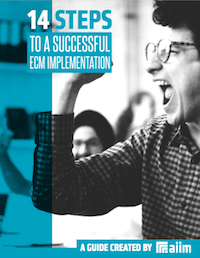The AIIM Blog
Keep your finger on the pulse of Intelligent Information Management with industry news, trends, and best practices.
Capture and Imaging | Digital Transformation
Before we get into how to tame your Information Chaos, let’s take a step back and look at WHY so many of us are experiencing it. These days, business information can come from anywhere, anytime, and in any form. Match this up with a growing volume and variety of the information we’re creating, and you can see how it can quickly get out of hand and become unmanageable without some strategies in place.
Share
While digital information accuracy is important to all document preservation, some institutions benefit from it more than others. Intelligent Information Management (IIM) and paperless offices are sufficient for most businesses, but if the content is important for historical or informational purposes rather than a backup, the quick and easy options for digitization don’t always do the trick. There are serious pitfalls of intelligent capture, especially if a precise representation of the document’s content is important to a collection, such as legal documents, documents used for research and reference, or a historical document collection like a digital library.
Share

Making an ECM implementation successful requires planning and attention to detail. The best way to create the right solution is to identify organizational goals and priorities. Learn how to manage a successful implementation in our free guide.
Capture and Imaging | Paperless Office
What is Capture? Despite technology, most companies continue to struggle to manage the burden of paper in many important business processes. And while there are many technological approaches to digital transformation, the first step is often scanning. Also known as “capture,” this capability is characterized by the ability to scan paper documents to store and use them in digital form instead of paper. First developed over 30 years ago, capture systems have evolved from simple solutions for basic scanning into sophisticated and expensive systems for enterprise-wide document automation. Therefore, it's important to understand and leverage scanning as a fundamental tool for business today.
Share
According to AIIM research, 75% of the organizations we surveyed view digital transformation as “important” or “very important” to their organization. Survey respondents point to techniques like advanced data capture, machine learning, and process automation to provide the powerful potential to reengineer and improve core business processes. The trouble, however, is that that the majority of information capture and content management solutions on the market have been built to work with highly-structured and pre-determined information and workflows. Feedback from our AIIM community of practitioners tells us that working with unstructured information is one of the biggest barriers to digital transformation.
Share
Earlier this year AIIM conducted a survey, in partnership with Parascript, called “The Leaders in Capture.” The purpose of this annual survey is to better understand how organizations are using advanced data capture techniques currently, what their vision and plans are for the technologies and capabilities in future, and where they feel are the roadblocks to success and the avenues to gaining advantage.
Share
Capture? Haven’t we been doing this for years and years? Well…yes and no. Yes, organizations have been scanning paper into digital archives for a long time. And for 72% of organizations, scanning paper is still the most important part of their information capture strategy. The continued importance of simply getting rid of the paper is not just a function of laggard organizations; the struggle to get rid of paper is consistent across all levels of overall competence.
Share